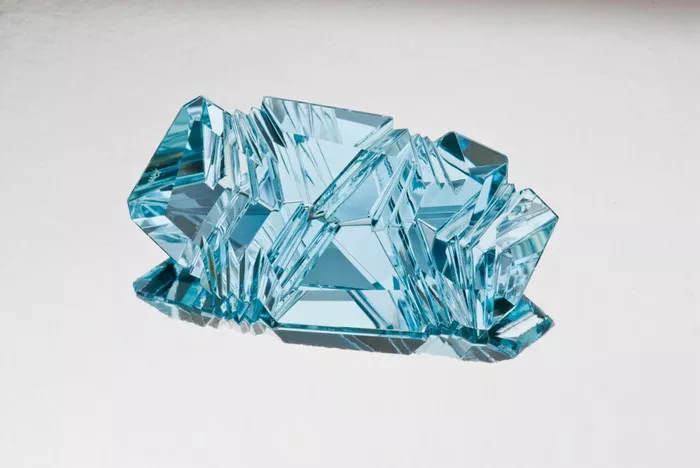The concept of “real” in the context of gemstones can be complex. When it comes to lab – made aquamarine, there are different aspects to consider. Lab – made aquamarine is created through artificial means in a laboratory setting. It has many similarities to natural aquamarine but also some key differences. To determine whether it is “real” requires an examination of its physical and chemical properties, as well as how it is perceived in the jewelry market.
Physical and Chemical Properties
Chemical Composition
Natural aquamarine is a beryl, which has the chemical formula Be3Al2(SiO3)6. Lab – made aquamarine also has the same basic chemical composition. It is composed of the same elements in the same proportions as its natural counterpart. In this sense, from a chemical perspective, it can be considered similar to natural aquamarine. For example, both natural and lab – made aquamarine contain beryllium, aluminum, silicon, and oxygen in the same general ratio.
Crystal Structure
The crystal structure of lab – made aquamarine is also similar to that of natural aquamarine. They both form in a hexagonal crystal system. The atoms are arranged in a way that gives the gemstone its characteristic shape and physical properties. However, the growth conditions in a laboratory can sometimes be more controlled than in nature, which may lead to some differences in the perfection of the crystal structure. But overall, the basic hexagonal pattern is the same.
Optical Properties
In terms of optical properties, lab – made and natural aquamarine share many similarities. They both have a refractive index in a similar range. The refractive index affects how light passes through the gemstone and is responsible for its sparkle and luster. Also, the color dispersion, which gives the gemstone its ability to split light into different colors, is comparable in both types. For instance, both types of aquamarine can show a beautiful blue color due to the way they interact with light.
Differences from Natural Aquamarine
Growth Environment
Natural aquamarine forms deep within the Earth’s crust over long periods of time. It is the result of complex geological processes involving heat, pressure, and the presence of certain minerals. Lab – made aquamarine, on the other hand, is grown in a controlled laboratory environment. This difference in growth environment can lead to some minor differences in the gemstone. For example, natural aquamarine may have inclusions that are characteristic of its geological formation, while lab – made aquamarine may have fewer or different types of inclusions.
Rarity and Value
Natural aquamarine is considered a natural resource, and its rarity is determined by the availability of deposits around the world. Some high – quality natural aquamarine can be quite rare and, as a result, valuable. Lab – made aquamarine, while not as rare in the sense that it can be produced in a laboratory, is often less expensive. The market generally places a higher value on natural aquamarine, especially for large, high – quality specimens.
Perceived Authenticity
In the jewelry market and among consumers, there is often a perception that natural gemstones are more “authentic” or “real.” This is due in part to the long – standing tradition of using natural gemstones in jewelry and the association of natural materials with luxury and uniqueness. Lab – made aquamarine may be seen as a more affordable alternative but not as “genuine” in the eyes of some consumers.
Applications in the Jewelry Market
Fashion Jewelry
Lab – made aquamarine has found a significant place in the fashion jewelry market. It offers a more affordable option for those who want the look of aquamarine without the high cost of natural gemstones. Fashion jewelry pieces with lab – made aquamarine can be mass – produced and are often used in trendy and seasonal designs. For example, in costume jewelry, lab – made aquamarine can be set in inexpensive metal settings to create a stylish and affordable piece.
Ethical and Sustainable Considerations
For some consumers, lab – made aquamarine is a more ethical and sustainable choice. Since it is not mined from the Earth, it does not contribute to the environmental and social issues associated with mining, such as habitat destruction and potential exploitation of miners. This has led to an increased interest in lab – made gemstones among those who are conscious of these issues.
Fine Jewelry
While natural aquamarine is more commonly used in fine jewelry, there are also some instances where lab – made aquamarine is being used. Some designers are starting to incorporate lab – made gemstones into their collections as a way to offer more affordable options or to make a statement about sustainability. However, it is still a relatively new trend in the fine jewelry world.
Conclusion
In conclusion, whether lab – made aquamarine is “real” depends on how one defines “real.” From a scientific perspective, it has the same chemical composition, crystal structure, and many of the same physical properties as natural aquamarine. However, it differs in terms of its growth environment, rarity, value, and perception in the market. In the jewelry market, it has its own niche, being more popular in fashion jewelry and gradually making inroads into fine jewelry for ethical and sustainable reasons. Ultimately, the answer to whether it is “real” may vary depending on the context, whether it is a scientific, market – related, or consumer – perception – based context.
Related topic:
- JCPenney Aquamarine Rings: A Buyer’s Guide
- Lucille Ball and Her Aquamarine Engagement Ring: A Love Story
- Why Choose an Ernest Jones Aquamarine Ring for Your Collection?


